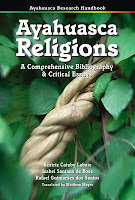An important recent social phenomenon has been the development and expansion of new religious movements in Brazil, which use ayahuasca as a central sacrament within a largely Christian theological and rhetorical context — referring to ayahuasca as the Blood of Christ, for example, or mareación, the ayahuasca experience, as awakening to Christ Consciousness. The Upper Amazonian contribution to these movements was the use of the basic ayahuasca drink, made from the ayahuasca vine and — exclusively — chacruna. Unlike the Upper Amazon, no other companion plants, such as chagroponga or sameruca, and no admixture plants, are used in the drink.
Other central aspects of the Upper Amazon culture area, particularly its shamanism, were also not adopted along with the ayahuasca drink. In fact, anthropologist Edward MacRae has specifically pointed out that Santo Daime has not incorporated such features of Amazonian shamanism as virotes, darts, arcanas, protections, phlegm, or Amazonian ideas of the moral ambiguity of the shaman. Rather, ayahuasca was incorporated as a sacrament into a folk Catholicism that had already been profoundly influenced by spiritism and Afro-Brazilian culture.
These religions began in the 1930s, when many Brazilian immigrants moved southwest to the Amazon seeking work tapping rubber trees. Most of these impoverished Brazilian immigrants became sedentary seringueros, but came in contact not only with indigenous Amazonians but also with itinerant mestizo caucheros from the Upper Amazon. Three of these Brazilian immigrants — Raimundo Irineu Serra (1892-1971), Daniel Pereira de Mattos (1904-1958), and José Gabriel da Costa (1922-1971) — founded new religions, mixing African-Brazilian, spiritist, and Christian elements with mestizo and indigenous use of ayahuasca.
 |
The Brazilian new religious movements have developed their own terminology for the ayahusca drink, often distinct from the terminology of their Upper Amazonian sources. Followers of Santo Daime and Barquinha call their sacred drink santo daime or simply daime, based on the words of Mestre Ireneu — daime força, daime amor, daime luz, give me strength, give me love, give me light. The ayahuasca vine, which they call cipo, vine, or jagube, is the masculine, solar aspect of the drink; the added leaf is called chacrona, or rainha, queen, or simply folha, leaf, and is its feminine, lunar aspect. Followers of the União do Vegetal call the drink hoasca or vegetal. The vine is called mariri, representing the masculine força, power, and the leaf is called chacruna, representing the feminine luz, light, in the combined drink. The various churches have also developed ceremonies quite different from those used for healing in the Upper Amazon.
 |
| Bia Labate |
The book consists of three parts. The first is a thorough overview of the history of the Brazilian ayahuasca religions, along with a critique of the main publications devoted to these religions, describing the characteristics, tendencies, and central perspectives in this research area. The second part discusses the most significant scientific investigations — pharmacological, psychiatric, and psychological — that have been published about these movements, including critical discussion of their results, contributions, and limitations. The third part is the most exhaustive bibliography to date on the topic of the Brazilian ayahuasca churches, including texts written in Danish, Dutch, English, French, German, Italian, Japanese, Norwegian, Portuguese, and Spanish. This list includes not only academic publications but also the texts of the new religious movements themselves. There is a foreword by Ralph Metzner.
More please.

- Previous Post: Listening to the Dreamer
- Next Post: The Psychedelic Review
- More Articles Related to: Ayahuasca, Books and Art



great article!!
I am very interested in what is happening in Brazil. It is so different from here where the absurd irrational ‘war on sacred medicine’ lurches from bad to more bad.
It is very interesting how it shows the great contrast between Santo Daime and Ayahuesceros ways.
It helps us feel the protean nature of Imagination which is prolific. How will WE westerners create communities that use sacred medicines? Will we have chance to find out? we must TAKE this chance.
I agree with you. It is exciting to see the ways that the plants keep reaching out to us, their wayward children. You’d think they would have given up by now. :-)
i have been around tribal friends who use the plant to do healings and for talking to the spirits. the effects of the plant on the people using it are harsh…not something to be celebrated